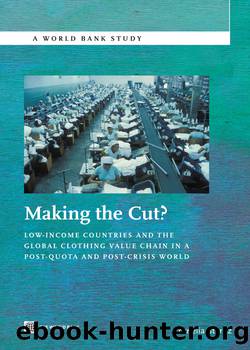Making the Cut?: Low-Income Countries and the Global Clothing Value Chain in a Post-Quota and Post-Crisis World by Cornelia Staritz

Author:Cornelia Staritz [Staritz, Cornelia]
Language: eng
Format: epub
ISBN: 978-0-8213-8636-1
Publisher: The World Bank
Published: 2011-09-15T00:00:00+00:00
Opportunities for regional suppliers
Large South African retailers recently have started to consider regional suppliers and Mauritius (in some cases together with Madagascar), Lesotho, and Swaziland have become important suppliers. In Lesotho and Swaziland this has occurred generally through relocations of already-existing South African supplier firms to Lesotho or Swaziland, but imports have also increased from some more embedded Taiwan, China-owned firms. Suppliers from Mauritius actively targeted the South African market and export either from Mauritius or Madagascar. However, despite these developments, there is much more potential for regional sourcing, in particular in the quick response, fashion, and short-run segment where regional suppliers have a potential competitive advantage compared to Asian suppliers. To realize this advantage, however, regional suppliers have to build relationships with South African retailers, restructure, and become capable of supplying short runs of more fashionable products with short lead times. There are several challenges to this strategy (see below) but it offers a huge opportunity to diversify export markets and to increase regional exports, in particular for South African-owned firms in Lesotho and Swaziland, firms in Mauritius, and some firms in Madagascar (and Kenya if trade barriers should be reduced) that are already geared to a greater extent to small-run and more fashionable products.
But not all firms are suited for this type of production. In particular, large Taiwan, China-owned firms in Lesotho and Swaziland that are set up for long-run basic products for the U.S. market are not competitive in the short run, fashion, and quick response business. It is also not useful that all firms in the region concentrate on quick response, fast fashion production, which is suitable for the South African market but not for other export markets such as the United States. But in the South African market there are also opportunities to engage in more basic and higher-volume production, in particular with the largest retailers such as Mr. Price, Woolworths, Edgars, and Pepkor. Some restructuring would be necessary as the volumes would not be comparable with U.S. volumes. However, the successful export experience of some Taiwan, China-owned firms from Swaziland and Lesotho suggests that the firms will be able to cope with these varying demands. Even if the volumes are smaller than preferable, this strategy can be very useful to fill capacity, stabilize seasonal fluctuations, and diversify end markets.
The supply chain rationalization model that became the dominant sourcing model for large global buyers in the United States and the EU has not become as important yet for South African buyers. Interviews with large South African retailers show that passive sourcing strategies, less involvement in sourcing, less formal and standardized rules, and absence of formal procedures of suppliersâ performance used to be prevalent. However, this seems to be changing and there is a process of supply chain rationalization underway. All retailers interviewed have started to get more involved in sourcing, and have established sourcing strategies and rules for suppliersâ selection and performance monitoring. They are also reducing or plan to reduce their supply base and focus on fewer, strategic relationships with core suppliers.
Download
This site does not store any files on its server. We only index and link to content provided by other sites. Please contact the content providers to delete copyright contents if any and email us, we'll remove relevant links or contents immediately.
The Brazilian Economy since the Great Financial Crisis of 20072008 by Philip Arestis Carolina Troncoso Baltar & Daniela Magalhães Prates(121348)
International Integration of the Brazilian Economy by Elias C. Grivoyannis(91272)
The Art of Coaching by Elena Aguilar(52948)
Flexible Working by Dale Gemma;(23254)
How to Stop Living Paycheck to Paycheck by Avery Breyer(19638)
The Acquirer's Multiple: How the Billionaire Contrarians of Deep Value Beat the Market by Tobias Carlisle(12241)
Thinking, Fast and Slow by Kahneman Daniel(12079)
The Radium Girls by Kate Moore(11921)
The Art of Thinking Clearly by Rolf Dobelli(10224)
Hit Refresh by Satya Nadella(9039)
The Compound Effect by Darren Hardy(8810)
Tools of Titans by Timothy Ferriss(8218)
Atomic Habits: Tiny Changes, Remarkable Results by James Clear(8186)
Turbulence by E. J. Noyes(7936)
A Court of Wings and Ruin by Sarah J. Maas(7652)
Change Your Questions, Change Your Life by Marilee Adams(7635)
Nudge - Improving Decisions about Health, Wealth, and Happiness by Thaler Sunstein(7615)
How to Be a Bawse: A Guide to Conquering Life by Lilly Singh(7393)
Win Bigly by Scott Adams(7094)
